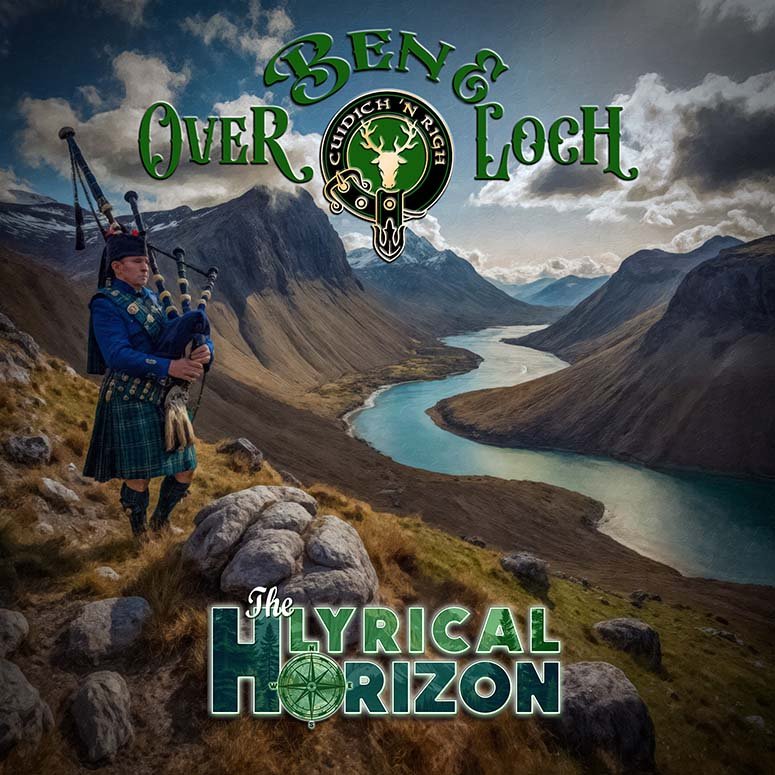"Over Ben and Loch (Os cionn Ben agus Loch)©"
Lyrics by M.S. McKenzie | Performed by American Storyteller Music & is Protected by Copyright

~ Associated State Links ~
State of SD Home Page | State of SD Gallery Page
"Over Ben and Loch (Thar Binn agus Loch)"
[Intro: starts off with a melancholic bagpipe solo that blends in to soaring violins and kettle drum beats]
[Verse 1]
On those days that have escaped me
Like big rivers flowing into the sea
Were the thoughts of the wanderer
And the love of the Highlander
[Chorus]
O'er Ben and Loch
I see the land
Thar Binn agus Loch
Chì mi'n tìr
[Verse 2]
I saw my heart in that way. How profound!
Leaping towards the hills and the mounds
And off in the distance, a mother crying
Maybe I will return, she said, sighing
[Chorus]
O'er Ben and Loch
I see the land
Thar Binn agus Loch
Chì mi'n tìr
[Verse 3]
And in the weeks of sailing across the sea
Like strangers of the ships, you and me
A great gray cloud overcame the ships
Then songs of joy sprang from my lips
[breakdown: soaring violins and harp, then electric guitars chime in]
[Verse 4]
I saw my heart in that way. How profound!
Leaping towards the hills and the mounds
And off in the distance, a mother laughing
For she did indeed return, she said, sighing
[Chorus]
O'er Ben and Loch
I see the land
Thar Binn agus Loch
Chì mi'n tìr
Chonaic mé mo chroí sa tslí sin, cé chomh domhain
Ag léim chuig na cnoic agus na buncanna
Agus i bhfad ar shiúl, máthair ag gáire
Mar a dtuairisc sí, tháinig sí ar ais, ag éirí as a intinn.
[Chorus]
Thar Binn agus Loch
Chì mi'n tìr
[insert soaring violins and drums…]
Thar Binn agus Loch
Chì mi'n tìr
Thar Binn agus Loch
Chì mi'n tìr
[Outro: Extended, upbeat Bagpipes and fiddle]
Song Description
BPM: 80–95
Style: Celtic-Folk Rock Ballad with Gaelic influences
Language Notes: Includes phrases in Scottish Gaelic (Chì mi'n tìr) and Irish Gaelic (Chonaic mé mo chroí sa tslí sin, cé chomh domhain)
Instrumentation: Bagpipes, soaring strings (violin & fiddle), kettle drums, harp, electric guitar accents
Mood: Reflective, cinematic, emotionally layered, ultimately triumphant
“Over Ben and Loch (Thar Binn agus Loch)” is a sweeping Celtic ballad that captures the soul of a Highland exile torn between longing and return. Set against the dramatic backdrop of Scotland’s rugged bens (mountains) and deep lochs (lakes), the song follows the emotional arc of a wandering soul; part poet, part emigrant; carrying love, memory, and ancestral echoes across the sea.
The intro begins with a solitary bagpipe, slow and mournful, calling across the mists like a voice from the hills. It is soon joined by soaring violins and deep kettle drums, building a sense of history and grandeur. This layered orchestration evokes the spirit of both loss and resilience that defines much of Celtic heritage.
In Verse 1, the narrator reflects on the passage of time as rivers flowing to sea; a metaphor for lives, memories, and traditions slipping away; while the mention of a "wanderer" and "Highlander" grounds the song in a historical and emotional journey.
The chorus, blending English and Scottish Gaelic, becomes a chant-like affirmation:
"O’er Ben and Loch / Thar Binn agus Loch / Chì mi'n tìr"
"I see the land," a powerful invocation of ancestral home and identity, repeated like a pilgrim’s prayer.
Verse 2 and Verse 4 mirror each other lyrically and thematically. The heart leaps toward the hills, a symbol of emotional truth and belonging. In the second verse, a mother cries, perhaps watching her child depart. In the fourth, that sorrow transforms; she laughs, for the return has come, turning longing into reunion.
Verse 3 introduces the crossing; the ocean voyage undertaken by many emigrants. The reference to strangers on ships and a gray cloud evokes hardship, but also transformation. The verse ends joyously, with songs erupting from the narrator’s lips, a burst of personal and cultural resilience.
The breakdown section features a crescendo of harp and strings, then electric guitars, signaling a shift from traditional lament to modern celebration—a bridge between old world and new.
The final chorus includes a beautifully constructed Irish Gaelic verse, reflecting the interconnectedness of the Celtic diaspora across Scotland and Ireland. It reiterates the return not just of a person, but of spirit and intention:
"Mar a dtuairisc sí, tháinig sí ar ais, ag éirí as a intinn."
("As she reported, she returned, rising from her mind.")
The outro bursts forth with fiddle and bagpipes, celebratory and unrestrained, like a ceilidh in full swing. It leaves the listener with a sense of joy, homecoming, and cultural endurance.
Themes:
- Exile and return
- Connection to land and ancestry
- The emotional legacy of migration
- Cultural duality (Scottish and Irish)
- Transformation of sorrow into song
